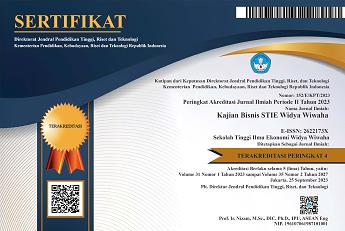APAKAH TRUST MEMDIASI PENGARUH PERCEIVED USEFULNESS DAN PERCEIVED EASE OF USE TERHADAP MINAT PENGGUNAAN QRIS?
DOI:
https://doi.org/10.32477/jkb.v33i2.1180Keywords:
QRIS, Perceived Usefulness, Perceived Ease of Use, Trust, Intention to Use, Generation ZAbstract
The Quick Response Code Indonesian Standard (QRIS), introduced by Bank Indonesia, aims to unify digital payment systems across Indonesia. However, despite substantial growth in QRIS transactions, the national adoption target is still not achieved, especially among Generation Z, a demographic that has high digital literacy. This study investigates the influence of two Technology Acceptance Model (TAM) constructs, perceived usefulness and perceived ease of use, on intention to adopt QRIS among Gen-Z in Yogyakarta, with trust as the mediating variable. A quantitative approach was taken using purposive sampling, with data collected from 98 respondents through an online questionnaire. Data was analyzed using Partial Least Squares-Structural Equation Modeling (PLS-SEM). The findings show that perceived usefulness and perceived ease of use significantly and positively influence QRIS usage intention, both directly and indirectly through trust. Trust emerges as an important mediating variable that increases the predictive power of TAM in the context of digital payment adoption. This study contributes to the theoretical advancement of TAM by integrating trust as a mediating construct, thereby enhancing its explanatory power in the context of Gen-Z digital payment adoption.
References
Agustian, R. T., & Wibisono, D. (2023). LITERASI KEUANGAN. Jurnal Ekonomi Dan Bisnis (EK Dan BI), 6(2), 203–212.
Ajzen, I. (2012). The theory of planned behavior. Handbook of Theories of Social Psychology: Volume 1, 50(2), 438–459. https://doi.org/10.4135/9781446249215.n22
Alalwan, A. A., Dwivedi, Y. K., & Rana, N. P. (2017). Factors influencing adoption of mobile banking by Jordanian bank customers: Extending UTAUT2 with trust. International Journal of Information Management, 37(3), 99–110. https://doi.org/10.1016/j.ijinfomgt.2017.01.002
Ardiyantama, M. I. (n.d.). Sistem penilaian kompetensi mahasiswa teknik informatika Universitas Islam Negeri Jakarta menggunakan metode topsis. Fakultas Sains dan Teknologi UIN Syarif HIdayatullah Jakarta.
Asyarofah, W., Vidiati, C., & Selasi, D. (2023). Pemahaman berinvestasi melalui financial technology (fintech) pada generasi Gen Z. Bridging: Journal Of Islamic Digital Economic and Management, 1(1), 164–171.
Bank Indonesia. (2023). Cara Membuat Qris All Payment Untuk Usaha. In Bank Indonesia. https://www.bi.go.id/id/publikasi/ruang-media/cerita-bi/Pages/cara-membuat-qris.aspx
Davis, F. D. (1989). Perceived usefulness, perceived ease of use, and user acceptance of information technology. MIS Quarterly: Management Information Systems, 13(3), 319–339. https://doi.org/10.2307/249008
Davis, F. D., Bagozzi, R. P., & Warshaw, P. R. (1989). User Acceptance of Computer Technology: A Comparison of Two Theoretical Models. Management Science, 35(8), 982–1003. https://doi.org/10.1287/mnsc.35.8.982
Desvronita. (2021). Faktor-Faktor yang Mempengaruhi Minat Menggunakan Sistem Pembayaran E-Wallet Menggunakan Technology Acceptance Model. Jurnal Akmenika, 18(2), 1–8.
Engko, C., Limba, F. B., & Achmad, A. P. (2023). Menggunakan Layanan Qris Dengan Technology Acceptance Model ( Tam ) Sebagai Variabel Mediasi. Jurnal Revenue Jurnal Akuntansi, 4(1), 386–397. https://revenue.lppmbinabangsa.id/index.php/home/article/view/274
Gefen, D., Karahanna, E., & Straub, D. W. (2003). Trust and tam in online shopping: AN integrated model. MIS Quarterly: Management Information Systems, 27(1), 51–90. https://doi.org/10.2307/30036519
Gultom, J. R., Setyawan, I., & Laksono, R. (2023). Peran kepercayaan dalam memediasi efek persepsi kemudahan dan persepsi nilai digital pada niat penggunaan kontinu e-payment. Mediastima, 29(1), 54–70.
Hafizah, R. N. H. (2023). “Pengaruh Kepercayaan, Kemudahan Penggunaan, Dan Pengetahuan Terhadap Keputusan Menggunakan Layanan Uang Elektronik (Qris) Pada Mahasiswa Uin Raden Fatah Palembang.” ADL ISLAMIC ECONOMIC : Jurnal Kajian Ekonomi Islam, 4(2), 134–151. https://doi.org/10.56644/adl.v4i2.56
Hair, Joseph F., Hult, Tomas M., Ringle, Cristian M., Sarstedt, M. (2022). A Primer on PARTIAL LEAST SQUARES STRUCTURAL EQUATION MADELING (PLS-SEM).
Hasanah, N. F., Miswardi, M., Anggraini, D., Febrian, H., & Sholihin, A. (2023). Implementasi Technology Acceptance Model dalam Penggunaan E-Money Terhadap Minat Menggunakan E-Money Dengan Pengaruh Resiko Penggunaan Sebagai Variabel Mediasi Perspektif Ekonomi Syariah. Jurnal Ilmiah Ekonomi Islam, 9(2), 2520. https://doi.org/10.29040/jiei.v9i2.8994
Kim, D. J., Ferrin, D. L., & Raghav Rao, H. (2009). Trust and satisfaction, two stepping stones for successful e-commerce relationships: A longitudinal exploration. Information Systems Research, 20(2), 237–257. https://doi.org/10.1287/isre.1080.0188
McKnight, D. H., Choudhury, V., & Kacmar, C. (2002). Developing and validating trust measures for e-commerce: An integrative typology. Information Systems Research, 13(3), 334–359. https://doi.org/10.1287/isre.13.3.334.81
Nurdin, Winda Nur Azizah, & Rusli. (2020). Pengaruh Pengetahuan,Kemudahan dan Risiko Terhadap Minat Bertransaksi Menggunakan Finansial Technology (Fintech) Pada Mahasiswa Institut Agama Islam Negeri (IAIN) Palu. Jurnal Ilmu Perbankan Dan Keuangan Syariah, 2(2), 199–222. https://doi.org/10.24239/jipsya.v2i2.32.198-221
Oliveira, T., Thomas, M., Baptista, G., & Campos, F. (2016). Mobile payment: Understanding the determinants of customer adoption and intention to recommend the technology. Computers in Human Behavior, 61, 404–414. https://doi.org/10.1016/j.chb.2016.03.030
Ramadhan, W., Daga, R., & Samad, A. (2023). Analisis Perilaku Nasabah Bank CIMB Niaga Makassar Terhadap Sistem Pembayaran Non Tunai QRIS. Jurnal Sains Manajemen Nitro, 2(2), 255–267. https://doi.org/10.56858/jsmn.v2i2.172
Seputri, W., Soemitra, A., & Bi Rahmani, N. A. (2022). Pengaruh Technolgy Acceptance Model terhadap Minat Mahasiswa Menggunakan Quick Response Code Indonesian Standard (QRIS)sebagai Cashless Society. MES Management Journal, 2(2), 116–126. https://doi.org/10.56709/mesman.v2i2.57
Silaen, E., & Prabawani, B. (2019). Persepsi Manfaat Serta Promosi Terhadap Minat Beli Ulang Saldo E-Wallet Ovo. Jurnal Ilmu Administrasi Bisnis, 8(4), 1–9.
Syahrina, A., & Christiana, I. (2023). Efek Mediasi Kepercayaan Pada Pengaruh Persepsi Manfaat dan Persepsi Kemudahan Terhadap Minat Menggunakan e-Money. Jurnal Ilmu Manajemen, 12(2), 161–175. http://jurnal.um-palembang.ac.id/ilmu_manajemen
Venkatesh, V., & Davis, F. D. (2000). Theoretical extension of the Technology Acceptance Model: Four longitudinal field studies. Management Science, 46(2), 186–204. https://doi.org/10.1287/mnsc.46.2.186.11926
Widhiaswara, I. A., & Soesanto, H. (2020). Analisis Pengaruh Persepsi Manfaat, Persepsi Kemudahan Penggunaan dan Persepsi Risiko Terhadap Keputusan Pembelian dengan Kepercayaan Sebagai Variabel Intervening (Studi Pada Konsumen Gofood di Kota Semarang). Jurnal Sains Pemasaran Indonesia (Indonesian Journal of Marketing Science), 19(2), 114–125. https://doi.org/10.14710/jspi.v19i2.114-125
Zhao, X., Lynch, J. G., & Chen, Q. (2010). Reconsidering Baron and Kenny: Myths and truths about mediation analysis. Journal of Consumer Research, 37(2), 197–206. https://doi.org/10.1086/651257
Zhou, T. (2011). Understanding mobile internet continuance usage from the perspectives of UTAUT and flow. Information Development, 27(3), 207–218. https://doi.org/10.1177/0266666911414596
Zhou, T. (2012). Examining mobile banking user adoption from the perspectives of trust and flow experience. Information Technology and Management, 13(1), 27–37. https://doi.org/10.1007/s10799-011-0111-8
Downloads
Published
How to Cite
Issue
Section
License
Copyright (c) 2025 Dyah Febriyani dan Tri Gunarsih

This work is licensed under a Creative Commons Attribution 4.0 International License.









